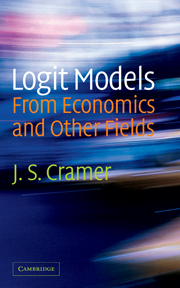Book contents
- Frontmatter
- Contents
- List of figures
- List of tables
- Preface
- 1 Introduction
- 2 The binary model
- 3 Maximum likelihood estimation of the binary logit model
- 4 Some statistical tests and measures of fit
- 5 Outliers, misclassification of outcomes, and omitted variables
- 6 Analyses of separate samples
- 7 The standard multinomial logit model
- 8 Discrete choice or random utility models
- 9 The origins and development of the logit model
- Bibliography
- Index of authors
- Index of subjects
7 - The standard multinomial logit model
Published online by Cambridge University Press: 11 January 2010
- Frontmatter
- Contents
- List of figures
- List of tables
- Preface
- 1 Introduction
- 2 The binary model
- 3 Maximum likelihood estimation of the binary logit model
- 4 Some statistical tests and measures of fit
- 5 Outliers, misclassification of outcomes, and omitted variables
- 6 Analyses of separate samples
- 7 The standard multinomial logit model
- 8 Discrete choice or random utility models
- 9 The origins and development of the logit model
- Bibliography
- Index of authors
- Index of subjects
Summary
This chapter and the next deal with extensions of the binary model to more than two outcomes. This chapter treats ordered probability models very briefly and the standard multinomial logit model at some length. The ordered probability models are a direct and fairly narrow generalization of the stimulus and response models of Section 2.2, and in particular of the latent regression equation of Section 2.3; the standard multinomial logit is a direct generalization of the binary logistic formula, without reference to any particular underlying idea. This model differs much more sharply from the binary model, and it is more versatile than the ordered model. Its properties as well as its estimation deserve a fuller explanation. We also give an empirical application, once more to household car ownership. The chapter is concluded by a a test for pooling states (and thereby reducing the number of distinct outcomes).
There are still other generalizations of the binary model to more than two alternatives, for this has been the chosen vehicle for more profound theories of choice behaviour which bring new practical implications with them. This is the subject of Chapter 8.
Ordered probability models
We recall the simple stimulus and response models and their formal representation in the latent regression equation model of Section 2.3.
- Type
- Chapter
- Information
- Logit Models from Economics and Other Fields , pp. 104 - 125Publisher: Cambridge University PressPrint publication year: 2003
- 1
- Cited by



